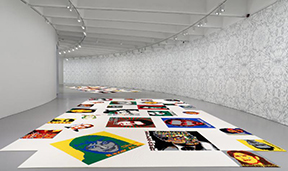|
The Hirshhorn Museum and Sculpture Garden has announced the acquisition of
  an expansive installation spanning over 1,200 feet and portraying individuals from around the world whom the artist and various human rights groups consider to be activists, prisoners of conscience and advocates of free speech. The museum has continued to be a major proponent of Ai Weiwei’s groundbreaking work after hosting the artist’s first United States retrospective in 2013. an expansive installation spanning over 1,200 feet and portraying individuals from around the world whom the artist and various human rights groups consider to be activists, prisoners of conscience and advocates of free speech. The museum has continued to be a major proponent of Ai Weiwei’s groundbreaking work after hosting the artist’s first United States retrospective in 2013.The installation comprises 176 portraits made of more than 1.2 million plastic LEGO® bricks, assembled by hand and laid out on the floor.Each portrait is pixelated, resembling surveillance or photos found on the internet. The graphic manipulation can symbolize the dissolving nature of the individual or may suggest that each person has been encoded as a form of digital data. Additionally, the colors in each portrait roughly represent the colors of the subject’s national flags. The work foregrounds Ai Weiwei’s own experiences of incarceration, interrogation and surveillance. In 2011, he was detained by the Chinese government for eighty-one days and then prohibited from traveling abroad until 2015.
Like Ai Weiwei, the individuals represented in “Trace” have been detained, exiled, or have sought political asylum because of their actions, beliefs or affiliations. Commissioned in 2014, “Trace” first opened as part of @Large: Ai Weiwei on Alcatraz, a site-specific takeover of the former Alcatraz Federal Penitentiary in San Francisco, and a collaboration between the nonprofit FOR-SITE Foundation, the National Park Service, and the Golden Gate Park Conservancy. “Trace” enters into the collection joining one previously acquired work by Ai Weiwei titled “Cube Light” which was acquired in 2012.
“This acquisition marks an exciting moment for the museum as we welcome a second work by Ai Weiwei, one of the most influential voices of the 21st century, into the collection,” said Hirshhorn Director Melissa Chiu. “His revolutionary practice has contributed to diverse conversations on a number of the most important global issues of our time, and we are honored to share this impactful installation-which addresses the intersection of history, politics and culture-with our Washington community and beyond.”
|